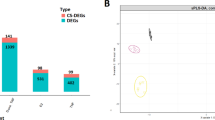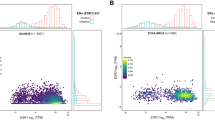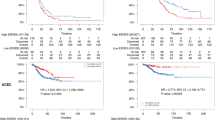Abstract
Transcriptional effects of estrogen result from its activation of two estrogen receptor (ER) isoforms; ERα that drives proliferation and ERβ that is antiproliferative. Expression of ERβ in xenograft tumors from the T47D breast cancer cell line reduces tumor growth and angiogenesis. If ERβ can halt tumor growth, its introduction into cancers may be a novel therapeutic approach to the treatment of estrogen-responsive cancers. To assess the complete impact of ERβ on transcription, we have made a full transcriptome analysis of ERα- and ERβ-mediated gene regulation in T47D cell line with Tet-Off regulated ERβ expression. Of the 35 000 genes and transcripts analysed, 4.1% (1434) were altered by ERα activation. Tet withdrawal and subsequent ERβ expression inhibited the ERα regulation of 998 genes and, in addition, altered expression of 152 non-ERα-regulated genes. ERα-induced and ERβ-repressed genes were involved in proliferation, steroid/xenobiotic metabolism and ion transport. The ERβ repressive effect was further confirmed by proliferation assays, where ERβ was shown to completely oppose the ERα–E2 induced proliferation. Additional analysis of ERβ with a mutated DNA-binding domain revealed that this mutant, at least for a quantity of genes, antagonizes ERα even more strongly than ERβ wt. From an examination of the genes regulated by ERα and ERβ, we suggest that introduction of ERβ may be an alternative therapeutic approach to the treatment of certain cancers.
This is a preview of subscription content, access via your institution
Access options
Subscribe to this journal
Receive 50 print issues and online access
$259.00 per year
only $5.18 per issue
Buy this article
- Purchase on Springer Link
- Instant access to full article PDF
Prices may be subject to local taxes which are calculated during checkout





Similar content being viewed by others
Accession codes
References
Annicotte JS, Chavey C, Servant N, Teyssier J, Bardin A, Licznar A et al. (2005). The nuclear receptor liver receptor homolog-1 is an estrogen receptor target gene. Oncogene 24: 8167–8175.
Buterin T, Koch C, Naegeli H . (2006). Convergent transcriptional profiles induced by endogenous estrogen and distinct xenoestrogens in breast cancer cells. Carcinogenesis 27: 1567–1578.
Chang EC, Frasor J, Komm B, Katzenellenbogen BS . (2006). Impact of estrogen receptor beta on gene networks regulated by estrogen receptor alpha in breast cancer cells. Endocrinology 147: 4831–4842.
Chen W-Y, Cheng B-C, Jiang M-J, Hsieh M-Y, Chang M-S . (2006). IL-20 is expressed in atherosclerosis plaques and promotes atherosclerosis in apolipoprotein E-deficient mice. Arterioscler Thromb Vasc Biol 26: 2090–2095.
Esslimani-Sahla M, Kramar A, Simony-Lafontaine J, Warner M, Gustafsson J-A, Rochefort H . (2005). Increased estrogen receptor {beta}cx expression during mammary carcinogenesis. Clin Cancer Res 11: 3170–3174.
Frasor J, Danes JM, Funk CC, Katzenellenbogen BS . (2005). Estrogen down-regulation of the corepressor N-CoR: mechanism and implications for estrogen derepression of N-CoR-regulated genes. Proc Natl Acad Sci USA 102: 13153–13157.
Frasor J, Danes JM, Komm B, Chang KCN, Lyttle CR, Katzenellenbogen BS . (2003). Profiling of estrogen up- and down-regulated gene expression in human breast cancer cells: insights into gene networks and pathways underlying estrogenic control of proliferation and cell phenotype. Endocrinology 144: 4562–4574.
Frasor J, Stossi F, Danes JM, Komm B, Lyttle CR, Katzenellenbogen BS . (2004). Selective estrogen receptor modulators: discrimination of agonistic versus antagonistic activities by gene expression profiling in breast cancer cells. Cancer Res 64: 1522–1533.
Gougelet A, Mueller SO, Korach KS, Renoir J-M . (2007). Oestrogen receptors pathways to oestrogen responsive elements: the transactivation function-1 acts as the keystone of oestrogen receptor (ER)[beta]-mediated transcriptional repression of ER[alpha]. J Steroid Biochem Mol Biol 104: 110–122.
Gustafsson J . (2006). ERb scientific visions translate to clinical uses. Climacteric 9: 156–160.
Hall JM, Korach KS . (2003). Stromal cell-derived factor 1, a novel target of estrogen receptor action, mediates the mitogenic effects of estradiol in ovarian and breast cancer cells. Mol Endocrinol 17: 792–803.
Hanstein B, Djahansouzi S, Dall P, Beckmann M, Bender H . (2004). Insights into the molecular biology of the estrogen receptor define novel therapeutic targets for breast cancer. Eur J Endocrinol 150: 243–255.
Harris MA, Clark J, Ireland A, Lomax J, Ashburner M, Foulger R et al. (2004). The Gene Ontology (GO) database and informatics resource. Nucleic Acids Res 32: D258–D261.
Hartman J, Lindberg K, Morani A, Inzunza J, Strom A, Gustafsson J-A . (2006). Estrogen receptor {beta} inhibits angiogenesis and growth of T47D breast cancer xenografts. Cancer Res 66: 11207–11213.
Hosack DA, Dennis Jr G, Sherman BT, Lane HC, Lempicki RA . (2003). Identifying biological themes within lists of genes with EASE. Genome Biol 4: R70.
Hsieh M-Y, Chen W-Y, Jiang M-J, Cheng B-C, Huang T-Y, Chang M-S . (2006). Interleukin-20 promotes angiogenesis in a direct and indirect manner. Genes Immun 7: 234–242.
Hsu Y-H, Li H-H, Hsieh M-Y, Liu M-F, Huang K-Y, Chin L-S et al. (2006). Function of interleukin-20 as a proinflammatory molecule in rheumatoid and experimental arthritis. Arthritis Rheum 54: 2722–2733.
Inoue A, Yoshida N, Omoto Y, Oguchi S, Yamori T, Kiyama R et al. (2002). Development of cDNA microarray for expression profiling of estrogen-responsive genes. J Mol Endocrinol 29: 175–192.
Kang H, Watkins G, Parr C, Douglas-Jones A, Mansel R, Jiang W . (2005). Stromal cell derived factor-1: its influence on invasiveness and migration of breast cancer cells in vitro, and its association with prognosis and survival in human breast cancer. Breast Cancer Res 7: R402–R410.
Kuiper GGJM, Enmark E, Pelto-Huikko M, Nilsson S, Gustafsson J-A . (1996). Cloning of a novel estrogen receptor expressed in rat prostate and ovary. Proc Natl Acad Sci USA 93: 5925–5930.
Kurebayashi J, Otsuki T, Kunisue H, Tanaka K, Yamamoto S, Sonoo H . (2000). Expression levels of estrogen receptor-{alpha}, estrogen receptor-{beta}, coactivators, and corepressors in breast cancer. Clin Cancer Res 6: 512–518.
Laganiere J, Deblois G, Lefebvre C, Bataille AR, Robert F, Giguere V . (2005). From the cover: location analysis of estrogen receptor {alpha} target promoters reveals that FOXA1 defines a domain of the estrogen response. Proc Natl Acad Sci USA 102: 11651–11656.
Lindberg MK, Moverare S, Skrtic S, Gao H, Dahlman-Wright K, Gustafsson J-A et al. (2003). Estrogen receptor (ER)-{beta} reduces ER{alpha}-regulated gene transcription, supporting a ‘Ying Yang’ relationship between ER{alpha} and ER{beta} in mice. Mol Endocrinol 17: 203–208.
Lo Y-L, Yu J-C, Chen S-T, Yang H-C, Fann CSJ, Mau Y-C et al. (2005). Breast cancer risk associated with genotypic polymorphism of the mitosis-regulating gene Aurora-A/STK15/BTAK. Int J Cancer 115: 276–283.
Marshburn PB, Zhang J, Bahrani-Mostafavi Z, Mostafavi BZ, Marroum M-C, Mougeot J-LC et al. (2004). Estrogen receptor-[alpha] messenger RNA variants that lack exon 5 or exon 7 are coexpressed with wild-type form in human endometrium during all phases of the menstrual cycle. Am J Obstet Gynecol 191: 626–633.
Matthews J, Wihlen B, Tujague M, Wan J, Strom A, Gustafsson J-A . (2006). Estrogen receptor (ER) {beta} modulates ER{alpha}-mediated transcriptional activation by altering the recruitment of c-Fos and c-Jun to estrogen-responsive promoters. Mol Endocrinol 20: 534–543.
McDonnell DP, Norris JD . (2002). Connections and regulation of the human estrogen receptor. Science 296: 1642–1644.
Murphy LC, Peng B, Lewis A, Davie JR, Leygue E, Kemp A et al. (2005). Inducible upregulation of oestrogen receptor-{beta}1 affects oestrogen and tamoxifen responsiveness in MCF7 human breast cancer cells. J Mol Endocrinol 34: 553–566.
Nikolova Z, Djonov V, Zuercher G, Andres A, Ziemiecki A . (1998). Cell-type specific and estrogen dependent expression of the receptor tyrosine kinase EphB4 and its ligand ephrin-B2 during mammary gland morphogenesis. J Cell Sci 111: 2741–2751.
Nilsson S, Makela S, Treuter E, Tujague M, Thomsen J, Andersson G et al. (2001). Mechanisms of estrogen action. Physiol Rev 81: 1535–1565.
Palmieri C, Cheng G, Saji S, Zelada-Hedman M, Warri A, Weihua Z et al. (2002). Estrogen receptor beta in breast cancer. Endocr Relat Cancer 9: 1–13.
Park K-J, Krishnan V, O’Malley BW, Yamamoto Y, Gaynor RB . (2005). Formation of an IKK[alpha]-dependent transcription complex is required for estrogen receptor-mediated gene activation. Mol Cell 18: 71–82.
Paruthiyil S, Parmar H, Kerekatte V, Cunha GR, Firestone GL, Leitman DC . (2004). Estrogen receptor {beta} inhibits human breast cancer cell proliferation and tumor formation by causing a G2 cell cycle arrest. Cancer Res 64: 423–428.
Poola I, Speirs V . (2001). Expression of alternatively spliced estrogen receptor alpha mRNAs is increased in breast cancer tissues. J Steroid Biochem Mol Biol 78: 459–469.
Rae JM, Johnson MD, Scheys JO, Cordero KE, Larios JM, Lippman ME . (2005). GREB1 is a critical regulator of hormone dependent breast cancer growth. Breast Cancer Res Treat 92: 141–149.
Real PJ, Sierra A, De Juan A, J.C S, Lopez-Vega JM, Fernandez-Luna JL . (2002). Resistance to chemotherapy via Stat3-dependent overexpression of Bcl-2 in metastatic breast cancer cells. Oncogene 21: 7611–7618.
Ricci MS, Toscano DG, Mattingly CJ, Toscano Jr WA . (1999). Estrogen receptor reduces CYP1A1 induction in cultured human endometrial cells. J Biol Chem 274: 3430–3438.
Richter K, Wirta V, Dahl L, Bruce S, Lundeberg J, Carlsson L et al. (2006). Global gene expression analyses of hematopoietic stem cell-like cell lines with inducible Lhx2 expression. BMC Genomics 7: [E-pub ahead of print].
Roberts M, Wallace J, Jeltsch J-M, Berry M . (1988). The 5′ flanking region of the human pS2 gene mediates its transcriptional activation by estrogen in MCF-7 cells. Biochem Biophys Res Commun 151: 306–313.
Russo J, Russo IH . (2006). The role of estrogen in the initiation of breast cancer. J Steroid Biochem Mol Biol 102: 89–96.
Schaefer TM, Wright JA, Pioli PA, Wira CR . (2005). IL-1{beta}-mediated proinflammatory responses are inhibited by estradiol via down-regulation of IL-1 receptor type I in uterine epithelial cells. J Immunol 175: 6509–6516.
Smyth G . (2004). Linear models and empirical Bayes methods for assessing differential expression in microarray experiments. Stat Appl Genet Mol Biol 3: Article 3.
Stossi F, Likhite VS, Katzenellenbogen JA, Katzenellenbogen BS . (2006). Estrogen-occupied estrogen receptor represses cyclin G2 gene expression and recruits a repressor complex at the cyclin G2 promoter. J Biol Chem 281: 16272–16278.
Strom A, Hartman J, Foster JS, Kietz S, Wimalasena J, Gustafsson J-A . (2004). Estrogen receptor {beta} inhibits 17{beta}-estradiol-stimulated proliferation of the breast cancer cell line T47D. Proc Natl Acad Sci USA 101: 1566–1571.
Tokes A-M, Kulka J, Paku S, Szik A, Paska C, Novak P et al. (2005). Claudin-1, -3 and -4 proteins and mRNA expression in benign and malignant breast lesions: a research study. Breast Cancer Res 7: R296–R305.
Tomasini R, Seux M, Nowak J, Bontemps C, Carrier A, Dagorn J-C et al. (2005). TP53INP1 is a novel p73 target gene that induces cell cycle arrest and cell death by modulating p73 transcriptional activity. Oncogene 24: 8093–8104.
Vlotides G, Eigler T, Melmed S . (2007). Pituitary tumor transforming gene: physiology and implications for tumorigenesis. Endocr Rev 28: 165–186.
Wang F, Lee E, Lowes MA, Haider AS, Fuentes-Duculan J, Abello MV et al. (2006). Prominent production of IL-20 by CD68+/CD11c+ myeloid-derived cells in psoriasis: gene regulation and cellular effects. J Invest Dermatol 126: 1590–1599.
Wang Y-h, Liu S, Zhang G, Zhou C-q, Zhu H-x, Zhou X-b et al. (2005). Knockdown of c-Myc expression by RNAi inhibits MCF-7 breast tumor cells growth in vitro and in vivo. Breast Cancer Res 7: R220–R228.
Acknowledgements
We thank Dr Chunyan Zhao and Associate Professor Karin Dahlman-Wright for valuable discussions. This study was supported by grants from the Swedish Cancer Fund and from KaroBio AB.
Author information
Authors and Affiliations
Corresponding author
Additional information
Supplementary Information accompanies the paper on the Oncogene website (http://www.nature.com/onc).
Supplementary information
Rights and permissions
About this article
Cite this article
Williams, C., Edvardsson, K., Lewandowski, S. et al. A genome-wide study of the repressive effects of estrogen receptor beta on estrogen receptor alpha signaling in breast cancer cells. Oncogene 27, 1019–1032 (2008). https://doi.org/10.1038/sj.onc.1210712
Received:
Revised:
Accepted:
Published:
Issue Date:
DOI: https://doi.org/10.1038/sj.onc.1210712
Keywords
This article is cited by
-
The estrogen receptor beta agonist liquiritigenin enhances the inhibitory effects of the cholesterol biosynthesis inhibitor RO 48-8071 on hormone-dependent breast-cancer growth
Breast Cancer Research and Treatment (2022)
-
Doxycycline promotes proteasome fitness in the central nervous system
Scientific Reports (2021)
-
PES1 promotes the occurrence and development of papillary thyroid cancer by upregulating the ERα/ERβ protein ratio
Scientific Reports (2019)
-
Promyelocytic Leukemia (PML) gene regulation: implication towards curbing oncogenesis
Cell Death & Disease (2019)
-
Estrogen-induced miR-196a elevation promotes tumor growth and metastasis via targeting SPRED1 in breast cancer
Molecular Cancer (2018)



